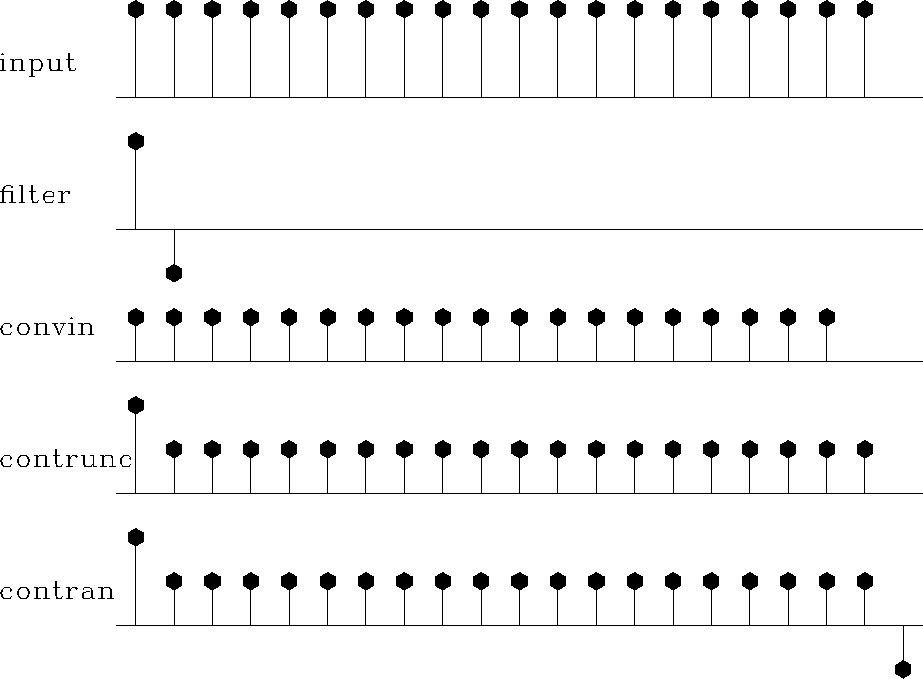




Next: Kirchhoff modeling and migration
Up: FAMILIAR OPERATORS
Previous: Product of operators
In practice, filtering generally consists of three parts:
(1) convolution,
(2) shifting to some preferred time alignment,
and (3) truncating so the output
has the same length as the input.
An adjoint program for this task,
is easily built from an earlier program.
We first make a simple time-shift program advance().
# signal advance: y(iy) = x(iy+jump)
#
subroutine advance( adj, add, jump, nx, xx, ny, yy)
integer ix, iy, adj, add, jump, nx, ny
real xx(nx), yy(ny)
call adjnull( adj, add, xx,nx, yy,ny)
do iy= 1, ny {
ix = iy + jump
if( ix >= 1 )
if( ix <= nx )
if( adj == 0 )
yy( iy) = yy( iy) + xx( ix)
else
xx( ix) = xx( ix) + yy( iy)
}
return; end
Although the code is bulky for such a trivial program,
it is easy to read,
works for any size of array,
and works whether the shift is positive or negative.
Since filtering ordinarily delays,
the advance() routine generally compensates.
Merging advance() with the earlier program contran()
according to the transpose rule  ,we get contrunc().
,we get contrunc().
# Convolve, shift, and truncate output.
#
subroutine contrunc( conj, add, lag, np,pp, nf,ff, nq,qq)
integer ns, conj, add, lag, np, nf, nq
real pp(np) # input data
real ff(nf) # filter (output at ff(lag))
real qq(nq) # filtered data
temporary real ss( np+nf-1)
ns = np + nf - 1
if( conj == 0 ) {
call contran( 0, 0, np,pp, nf,ff, ss)
call advance( 0, add, lag-1, ns,ss, nq,qq)
}
else { call advance( 1, 0, lag-1, ns,ss, nq,qq)
call contran( 1, add, np,pp, nf,ff, ss)
}
return; end
For a symmetrical filter,
a lag parameter half of the filter length would be specified.
The output of a minimum-phase filter is defined to be
at the beginning of the filter,
ff(1), so then lag=1.
The need for an adjoint filtering program will
be apparent later, when we design filters for prediction
and interpolation.
The program variable add happens to be useful when there
are many signals.
Our first real use of add will be found
in the subroutine stack1() ![[*]](http://sepwww.stanford.edu/latex2html/cross_ref_motif.gif) .
.
Another goal of convolution programs is that zero data not be assumed
beyond the interval for which the data is given.
This can be important in filter design and spectral estimation,
when we do not want the truncation at the end of the data
to have an effect.
Thus the output data is shorter than the input signal.
To meet this goal, I prepared subroutine convin().
# Convolve and correlate with no assumptions off end of data.
#
subroutine convin( adj, add, nx, xx, nb, bb, yy)
integer ib, iy,ny, adj, add, nx, nb
real xx(nx) # input signal
real bb(nb) # filter (or output crosscorrelation)
real yy(nx-nb+1) # filtered signal (or second input signal)
ny = nx - nb + 1 # length of filtered signal
if( ny < 1 ) call erexit('convin() filter output negative length.')
call adjnull( adj, add, bb, nb, yy, ny)
if( adj == 0 )
do iy= 1, ny {
do ib= 1, nb {
yy( iy) = yy( iy) + bb(ib) * xx( iy-ib+nb)
}}
else
do ib= 1, nb {
do iy= 1, ny {
bb( ib) = bb( ib) + yy(iy) * xx( iy-ib+nb)
}}
return; end
By now you are probably tired of looking at so many variations on convolution;
but convolution is the computational equivalent
of ordinary differential equations,
its applications are vast,
and end effects are important.
The
end effects
of the convolution programs are summarized
in Figure 1.
conv
Figure 1
Example of convolution end effects.
From top to bottom:
(1) input;
(2) filter;
(3) output of convin();
(4) output of contrunc() with no lag (lag=1); and
(5) output of contran().
|
|  |










Next: Kirchhoff modeling and migration
Up: FAMILIAR OPERATORS
Previous: Product of operators
Stanford Exploration Project
10/21/1998
![[*]](http://sepwww.stanford.edu/latex2html/cross_ref_motif.gif) .
.
